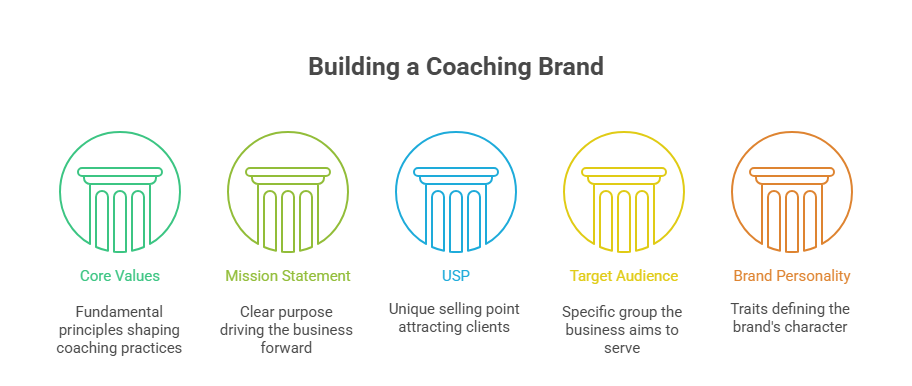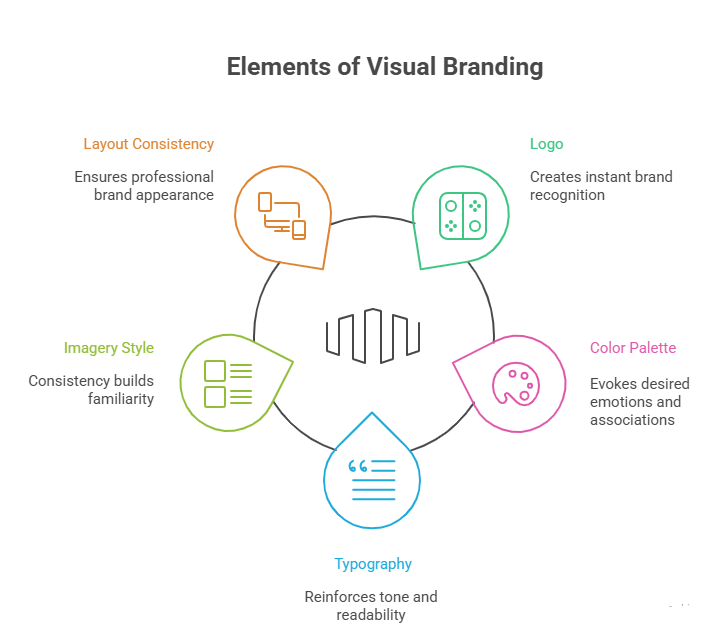Branding Basics Every New Coach Should Master
Your brand is more than a logo—it’s the perception and trust your audience builds about you from every interaction. For new coaches, strong branding is not optional; it’s the foundation that shapes your market position, attracts ideal clients, and communicates your value instantly.
In this guide, we’ll break down the branding elements every new coach must master—from defining your brand identity to crafting a cohesive voice, leveraging social proof, and avoiding costly mistakes. You’ll also see how the Health and Life Coach Certification can elevate your credibility and position you as a premium choice in a competitive market.
Defining Your Brand Identity
Core Values and Mission Statement
Your brand identity begins with a clear understanding of what you stand for. Core values act as the compass that guides your decisions, client relationships, and marketing strategies. They should be specific and actionable—not vague terms like “excellence” or “integrity,” but statements that reflect how you operate in practice. For example, “empowering clients through evidence-based coaching” communicates both a value and a method.
Your mission statement builds on those values by clearly stating who you serve, the transformation you deliver, and how you deliver it. A strong mission statement is short, memorable, and client-focused. Avoid jargon—your ideal client should understand it without explanation. When your core values and mission are aligned, you create a consistent foundation that informs every brand element, from visuals to client onboarding processes.
Unique Selling Proposition (USP)
Your unique selling proposition differentiates you from every other coach in your niche. It answers the question, “Why should a client choose me over others?” To develop your USP, identify the intersection of your expertise, your client’s most pressing needs, and the gap in your competitive landscape.
This might be a proprietary coaching framework, a specialized niche, or the integration of your Health and Life Coach Certification with a unique methodology. Your USP should be clear enough to use in an elevator pitch and compelling enough to influence buying decisions. When consistently communicated, your USP becomes a magnet for ideal clients who resonate with your specific strengths and approach.
Visual Branding Essentials
Logo Design Principles
Your logo is the most visible symbol of your brand, but it’s only effective when it’s simple, versatile, and meaningful. Simplicity ensures it’s recognizable at any size—from a website header to a social media icon. Versatility means it works in black and white, on different backgrounds, and across both digital and print mediums.
Avoid overcomplicated designs or trendy elements that will look outdated in a year. A good logo should reflect your niche or values without being overly literal—abstract symbols or clean typography often work better than complex illustrations. If you’re not a designer, invest in professional help. A well-crafted logo is a long-term asset that reinforces brand recognition and communicates professionalism before a single word is spoken.
Color Psychology and Font Selection
Colors influence perception and trigger emotional responses. Blue often signals trust and professionalism, while green suggests growth and renewal—both strong fits for coaching brands. Select a palette of two to three primary colors and one or two accent colors for consistency.
Font selection also shapes your brand tone. Sans-serif fonts communicate modernity and approachability, while serif fonts signal tradition and stability. Pair fonts strategically to balance personality with readability. Consistency in typography across all brand materials reinforces a cohesive, trustworthy image.
Consistent Imagery Use
Use imagery that reflects your brand’s personality and resonates with your target audience. Whether stock photos or custom photography, maintain a consistent style in lighting, tone, and subject matter. This visual consistency strengthens brand cohesion and makes your content instantly recognizable.
Crafting a Cohesive Brand Voice
Tone for Different Platforms
Your brand voice should feel consistent everywhere, but tone adjustments are necessary depending on the platform. LinkedIn content can be more formal and data-driven, while Instagram captions may lean conversational and motivational. Email sequences might mix professionalism with warmth, building trust while driving action. The key is ensuring every tone variation still reflects your core brand personality so clients instantly recognize you regardless of the channel.
Aligning Messaging with Target Audience
Your messaging must connect directly to the needs, desires, and language of your ideal clients. Use the phrases they naturally use to describe their struggles and aspirations—this creates instant relatability. Align your calls to action, benefits, and even metaphors with what resonates in your audience’s world. When your messaging feels like a mirror of their thoughts, it becomes a powerful tool for conversion, positioning you as a coach who truly understands their challenges.
Avoiding Inconsistency Across Channels
Inconsistency confuses prospects and weakens your credibility. This happens when your website tone, social media voice, and email style feel disconnected. To prevent this, create brand voice guidelines that define vocabulary, tone shifts, and content style for each channel. Train yourself and your team to follow them religiously so your brand experience remains seamless.
Building Credibility and Trust
Social Proof and Testimonials
Social proof turns abstract promises into tangible evidence. Gather testimonials that go beyond generic praise—ask clients to detail the specific challenges they faced, the steps you guided them through, and the measurable results achieved. Include diverse formats: written quotes, video clips, and case studies. Feature these across your website, social media, and proposals to reinforce trust at every touchpoint.
You can also leverage authority indicators like guest appearances on podcasts, speaking engagements, or collaborations with reputable brands. These endorsements signal to potential clients that others value and respect your expertise, making it easier for them to commit to your services.
Transparency in Messaging
Transparency builds credibility faster than polished sales language. Be clear about your process, pricing, and expectations from the start. Share what’s included in your coaching, the type of results clients can expect, and the work they’ll need to put in. Avoid overpromising—clients respect honesty, especially when it includes realistic timelines and potential challenges.
When you’re upfront, you position yourself as a trustworthy partner in their journey rather than just another service provider. This openness not only earns respect but also fosters stronger long-term relationships with your clients.
| Strategy | How It Builds Trust |
|---|---|
| Testimonials | Real client success stories |
| Case Studies | Proof of measurable results |
| Certifications | Shows verified expertise |
| Social Proof | Followers, shares, reviews |
| Transparency | Clear pricing and service details |
Avoiding Common Branding Mistakes
Overcomplicating Your Brand Identity
New coaches often try to pack too much into their branding—multiple logos, an excess of colors, conflicting taglines—resulting in a confusing message. Simplicity is strategic. A streamlined brand identity is easier to remember, easier to apply across channels, and far more effective at communicating what you do and who you serve.
Every element should have a clear purpose. If a logo variation, color, or phrase doesn’t support your positioning, remove it. The goal is to create instant recognition and trust without making prospects work to understand your offer. Complexity dilutes clarity; clarity drives conversions.
Ignoring Audience Feedback
Your brand isn’t for you—it’s for your clients. Dismissing or avoiding feedback means you might miss critical cues about whether your visuals, messaging, or positioning are resonating. Collect insights through polls, surveys, or direct conversations with your ideal client base.
If multiple prospects misunderstand your offer or find your brand unrelatable, it’s a signal to refine your approach. Listening to your audience ensures your brand evolves in alignment with their needs, making it stronger and more profitable over time.
| Mistake | Why It Hurts Your Brand |
|---|---|
| Overcomplicating Identity | Confuses audience and dilutes message |
| Inconsistent Messaging | Reduces brand trust |
| Ignoring Feedback | Missed opportunities for improvement |
| Trend Chasing | Makes brand appear inauthentic |
| Poor Visual Quality | Signals lack of professionalism |
Elevating Your Brand with the Health and Life Coach Certification
Earning the Health and Life Coach Certification is more than a credential—it’s a strategic asset that positions you as a credible authority in a competitive market. Prospective clients are increasingly skeptical of unverified coaches, and formal certification gives them tangible proof of your expertise.
Certified coaches can use the designation across websites, social media bios, and marketing materials to create instant trust. It signals that you’ve met rigorous training standards and operate within an ethical framework, both of which are critical to winning high-value clients.
Beyond authority, certification also strengthens your offer. You gain access to proven coaching methodologies, industry best practices, and structured tools that elevate client results. These assets can be integrated into your programs, helping you deliver consistent, measurable outcomes—the kind that drive testimonials, referrals, and repeat business.
If you’re aiming to build a premium brand, this certification separates you from generalists and positions you as a sought-after specialist.
Frequently Asked Questions
-
The Health and Life Coach Certification serves as third-party validation of your skills, training, and adherence to professional standards. In a market where anyone can call themselves a coach, this distinction builds instant trust with prospective clients. It demonstrates that you’ve undergone structured training, mastered evidence-based coaching techniques, and are committed to ethical practices. This credibility not only shortens the decision-making cycle for potential clients but also allows you to confidently charge premium rates without resistance.
-
Yes—branding is essential from day one. Without a clear, consistent brand identity, your marketing becomes scattered and ineffective. Early branding ensures that every touchpoint—your website, social media, and client interactions—communicates the same value proposition. Strong branding establishes recognition, trust, and memorability, which are critical for attracting your ideal audience. Skipping this step often results in wasted time, lower conversions, and a harder uphill climb to stand out later.
-
Color psychology plays a major role in how your brand is perceived. Start by identifying the emotions you want to evoke—calm, motivation, empowerment, or trust. For example, blue conveys professionalism and reliability, while green reflects health and growth. Ensure your chosen palette is versatile for both digital and print use, and limit it to two primary colors with one accent for consistency. Test your palette in mockups to see how it performs across platforms before finalizing.
-
Your mission statement defines your purpose—why your coaching business exists and the long-term impact you aim to create. Your unique selling proposition (USP), on the other hand, communicates what makes your offer different and better than others in the market. The mission speaks to vision and values, while the USP is about positioning and competitive advantage. Both work together: the mission inspires trust and alignment, while the USP converts interest into clients.
-
At minimum, review your brand annually to ensure it still aligns with your audience, offer, and market trends. However, major business shifts—such as launching a new coaching program, serving a different audience, or repositioning your services—should trigger a brand review immediately. Avoid constant changes that confuse your audience, but remain flexible enough to evolve when client feedback or industry shifts demand it.
-
Yes, but timing and transparency are key. If you’ve made a misstep—such as unclear messaging, poor logo design, or inconsistent visuals—acknowledge the update as a strategic improvement. Reintroduce your refined branding with a clear explanation of how it benefits your clients. Done correctly, rebranding can strengthen loyalty by showing that you’re committed to delivering a better client experience.
-
A consistent brand voice creates familiarity, which builds trust over time. Whether your tone is empathetic, motivational, or direct, it should align with your audience’s preferences and remain consistent across platforms. This uniformity reassures potential clients that they know what to expect when working with you. Inconsistent voice patterns, by contrast, create uncertainty and hesitation, lowering conversion rates.
Our Verdict
Branding isn’t decoration—it’s the foundation of your coaching business’s success. From your core values to your color palette, every decision should intentionally shape how potential clients perceive and connect with you. By defining your brand identity early, maintaining consistent visuals and messaging, and leveraging credentials like the Health and Life Coach Certification, you position yourself as a trusted authority from day one. Avoid the common mistakes that dilute credibility, stay responsive to audience feedback, and keep your brand aligned with both your mission and market demand. When executed strategically, branding becomes a growth engine—turning visibility into authority, and authority into long-term, high-value clients.
Which branding area will you prioritize first?
| Brand Identity (values, mission, USP) |
| Visual Branding (logo, colors, typography) |
| Brand Voice & Messaging (tone, copy, CTAs) |
Which branding area will you prioritize first?
| Brand Identity (values, mission, USP) |
| Visual Branding (logo, colors, typography) |
| Brand Voice & Messaging (tone, copy, CTAs) |




